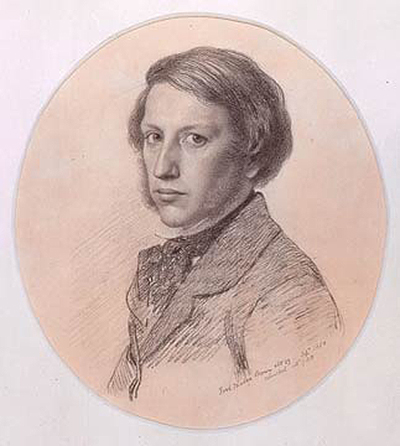Ford Madox Brown produced huge numbers of study sketches during his career, one of which is captured to the left here - a self portrait in pencil.
For many generations after his passing it was only his paintings that received any interest, though in recent times there has been a greater effort to draw together his sketches and to properly document them for the first time. This has been the case with a number of other artists, where this medium was previously regarded as purely a supporting element to the more impressive and challenging use of oils or tempura. One can also start to better understand the development processes of an artist by studying the earlier stages of their work. Some of Ford Madox Brown's creations were exceptionally detailed - the likes of Work could not just be painted off the cuff, without any prior planning of the layout and general theme.
Portraiture was this artist's main genre and it requires large amounts of practice and experimentation in order to be mastered - even the Renaissance masters such as Da Vinci and Michelangelo would work tirelessly on scraps of paper to hone their skills, often taking on individual limbs or poses one at a time, before later placing all elements together in an overall composition. Brown was loosely a part of the Pre-Raphaelites and many other members of the group were also highly skilled draughtsmen. You will also see impressive artworks within these collections of William Holman Hunt drawings. Additionally, there were some beautifully constructed portrait drawings from Edward Burne-Jones too, though he was most famously remembered for his contributions to the mediums of painting and also stained glass window designs and construction.
The discipline of drawing is typically most important in the early years of most artist's development, where they start to understand many elements of art before moving onto the more complex mediums such as painting or sculpture. Brown actually practiced his talents by copying existing prints from an early age and it was this that initially showed some elements of promise, which could then lead to more opportunities. We know that the prints he chose to study were from old masters, but specific names have never been uncovered. It is likely that these names would have come from the Italian Renaissance and perhaps also the Dutch Golden Age. Reproduction by hand was how many artists first started, with Nuremburg master, Albrecht Durer, studying the sketches in his father's botanical books, for example. He would then go on to use the natural talents in woodcuts, engraving and as a basis for his paintings as well.
Another interesting aspect to this art form, due to the speed at which drawings can be completed, is that Brown would sit for many of his colleagues, as well as producing portraits of them himself. There are several portraits of him from Rossetti's career and it is likely that many more related items exist but have been lost due to their fragile nature or have simply not been discovered and attributed yet. To compare self-portraits with those created by other artists offers an interesting comparison between how someone would see themselves, as well as how others viewed them. Sketches also offer a beautifully simple version of artistic portraits, going almost back to basics that appeals to many amateur artists today who desire to understand and learn the rawest elements of working before moving onto more complex techniques.
There has also been a growing interest in exhibitions of drawings in recent years with more and more venues looking to avoid the more expensive and harder to acquire paintings from an artist's career, and instead offering an alternative view on his career. These have been particularly suitable for smaller venues who cannot afford the insurance costs with hosting such expensive paintings but are still able to promote events with original work of well known artists and boost their attendance figures as a result. Some artist's collections of drawings have been a part of various notepads or sketchbooks, making studies of their travels particularly interesting and also easy to chronicle. The likes of Turner would work exclusively from these tools during his trips abroad, though the individual sleeves would later be pulled out and kept seperately.




